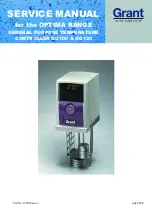
5 Fault
Finding
WARNING: These instructions are
for use only by suitably qualified personnel.
To reduce the risk of electric shock while
working on the equipment when switched on,
refer to the wiring and circuit diagrams, which
shows where ac power is present. In
particular, keep tools and fingers clear of
connections at the triac, ac transformer, and
power input connector. The wearing of dry
rubber gloves is recommended.
CAUTION:
Before undertaking work
on the unit, check that the correct fuses
Check that the available AC power supply is
correct for the unit, (see serial number plate).
5.1 Test equipment and tools required:
Digital Multimeter
Ranges: 250V
AC
10A
AC
20V
DC
Digital thermometer
Range: 0 to 100 C (0.1 C resolution)
5.2 Initial
Tests.
Fit the unit in its normal operating
position on a test tank.
Pour in sufficient cold water to cover the
heater.
Plug unit into the a.c. power supply and
switch on. Check that the displays comes on.
If it does not check the a.c. power supply
voltage and the fuses, two in the unit and
one in the plug.
Switch unit on and set temperature below
water temperature check that the alarm neon
is not lit.
If alarm neon is lit then check that there is
enough water in the test tank to lift the float
to operate the float micro switch. If the unit is
a GD120 and the alarm neon is still on check
that the over temperature cut-out is turned
fully clockwise and reset button is pressed.
Check that the stirrer is working. If stirrer is
not running check that the motor shaft turns
freely. If it is jammed the motor internal cut-
out may have tripped.
Free stirrer motor and allow time for the re-
settable internal trip to reset. If the motor is
still not running it probably has an open
circuit winding.
Disconnect motor and check continuity, if it is
open circuit the motor will have to be
replaced .
Set unit temperature above the water
temperature. Check that the heater neon
comes on and the bath
temperature increases and stabilizes at the
set temperature.
If the temperature either does not increase or
continues to rise above the set temperature
there is a fault with the temperature control
and the following procedure should be
carried out.
5.3
Fault Diagnosis.
Whilst it is not possible to cover all fault
conditions, the procedures given on the
following page provide guidance.
Plug the unit into an AC power supply and
switch on.
GD100/GD120
Part No. 17592/Issue 1
July 2002
Page 9
Summary of Contents for OPTIMA RANGE GD100
Page 25: ...B x4 A C Fig 7 Fig 8 Fig 9 GD100 GD120 Part No 17592 Issue 1 July 2002 Page 25 ...
Page 26: ...D E x2 F PCB Clip D Fig 10 Fig 11 Fig 12 GD100 GD120 Part No 17592 Issue 1 July 2002 Page 26 ...
Page 28: ...Part No 17592 Issue 1 July 2002 Fig 16 J K x4 L Fig 17 M M M Fig 18 Page 28 ...
Page 30: ......
Page 31: ......










































